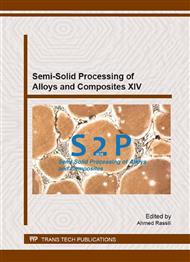p.282
p.288
p.294
p.303
p.309
p.314
p.319
p.328
p.334
Manufacturing and Fatigue Verification of Two Different Components Made by Semi-Solid Processing of Aluminium TX630 Alloy
Abstract:
Although rheocasting is widely used for the production of thin-walled components, thick-walled rheocast components are not yet common. In this paper, thick-walled semi-solid cast components were manufactured using serial production equipment. The aim of the investigation was to replace components made of spheroidal graphite cast iron (SGI) and conventionally cast aluminium in order to lower the weight of the truck, and still fulfill the high demands set on serial production. The rheocasting process used was a modified Rapid-S process coupled with a TX630 aluminium alloy and T5 or T7 heat treatment. Two different serial production rheocast components were fatigue tested by means of constant amplitude rig testing in order to define Wöhler curves. Moreover, multi-axial shake testing with signals recorded from proving ground was carried out. Fracture surfaces as well as metallographic samples were investigated.
Info:
Periodical:
Pages:
328-333
Citation:
Online since:
September 2016
Keywords:
Price:
Сopyright:
© 2016 Trans Tech Publications Ltd. All Rights Reserved
Share:
Citation:


